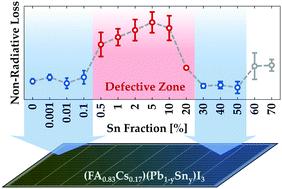当前位置:
X-MOL 学术
›
Energy Environ. Sci.
›
论文详情
Our official English website, www.x-mol.net, welcomes your
feedback! (Note: you will need to create a separate account there.)
Metal composition influences optoelectronic quality in mixed-metal lead–tin triiodide perovskite solar absorbers
Energy & Environmental Science ( IF 32.4 ) Pub Date : 2020-05-01 , DOI: 10.1039/d0ee00132e Matthew T. Klug 1, 2, 3, 4, 5 , Rebecca L. Milot 1, 2, 3, 4, 5 , Jay B. Patel 1, 2, 3, 4, 5 , Thomas Green 1, 2, 3, 4, 5 , Harry C. Sansom 1, 2, 3, 4, 5 , Michael D. Farrar 1, 2, 3, 4, 5 , Alexandra J. Ramadan 1, 2, 3, 4, 5 , Samuele Martani 6, 7, 8, 9 , Zhiping Wang 1, 2, 3, 4, 5 , Bernard Wenger 1, 2, 3, 4, 5 , James M. Ball 1, 2, 3, 4, 5 , Liam Langshaw 1, 2, 3, 4, 5 , Annamaria Petrozza 6, 7, 8, 9 , Michael B. Johnston 1, 2, 3, 4, 5 , Laura M. Herz 1, 2, 3, 4, 5 , Henry J. Snaith 1, 2, 3, 4, 5
Energy & Environmental Science ( IF 32.4 ) Pub Date : 2020-05-01 , DOI: 10.1039/d0ee00132e Matthew T. Klug 1, 2, 3, 4, 5 , Rebecca L. Milot 1, 2, 3, 4, 5 , Jay B. Patel 1, 2, 3, 4, 5 , Thomas Green 1, 2, 3, 4, 5 , Harry C. Sansom 1, 2, 3, 4, 5 , Michael D. Farrar 1, 2, 3, 4, 5 , Alexandra J. Ramadan 1, 2, 3, 4, 5 , Samuele Martani 6, 7, 8, 9 , Zhiping Wang 1, 2, 3, 4, 5 , Bernard Wenger 1, 2, 3, 4, 5 , James M. Ball 1, 2, 3, 4, 5 , Liam Langshaw 1, 2, 3, 4, 5 , Annamaria Petrozza 6, 7, 8, 9 , Michael B. Johnston 1, 2, 3, 4, 5 , Laura M. Herz 1, 2, 3, 4, 5 , Henry J. Snaith 1, 2, 3, 4, 5
Affiliation

|
Current designs for all-perovskite multi-junction solar cells require mixed-metal Pb–Sn compositions to achieve narrower band gaps than are possible with their neat Pb counterparts. The lower band gap range achievable with mixed-metal Pb–Sn perovskites also encompasses the 1.3 to 1.4 eV range that is theoretically ideal for maximising the efficiency of single-junction devices. Here we examine the optoelectronic quality and photovoltaic performance of the ((HC(NH2)2)0.83Cs0.17)(Pb1−ySny)I3 family of perovskite materials across the full range of achievable band gaps by substituting between 0.001% and 70% of the Pb content with Sn. We reveal that a compositional range of “defectiveness” exists when Sn comprises between 0.5% and 20% of the metal content, but that the optoelectronic quality is restored for Sn content between 30–50%. When only 1% of Pb content is replaced by Sn, we find that photoconductivity, photoluminescence lifetime, and photoluminescence quantum efficiency are reduced by at least an order of magnitude, which reveals that a small concentration of Sn incorporation produces trap sites that promote non-radiative recombination in the material and limit photovoltaic performance. While these observations suggest that band gaps between 1.35 and 1.5 eV are unlikely to be useful for optoelectronic applications without countermeasures to improve material quality, highly efficient narrower band gap absorber materials are possible at or below 1.33 eV. Through optimising single-junction photovoltaic devices with Sn compositions of 30% and 50%, we respectively demonstrate a 17.6% efficient solar cell with an ideal single-junction band gap of 1.33 eV and an 18.1% efficient low band gap device suitable for the bottom absorber in all-perovskite multi-junction cells.
中文翻译:

金属成分影响混合金属铅-三碘锡钙钛矿型太阳能吸收器的光电质量
当前用于全钙钛矿多结太阳能电池的设计需要混合金属Pb-Sn成分以实现比其纯Pb对应物更窄的带隙。混合金属Pb-Sn钙钛矿可获得的较低带隙范围也包含1.3至1.4 eV的范围,这在理论上是使单结器件效率最大化的理想选择。在这里我们检查((HC(NH 2)2)0.83 Cs 0.17)(Pb 1− y Sn y)I 3的光电质量和光伏性能钙钛矿材料的整个系列,通过用Sn替代0.001%至70%的Pb含量,可实现整个带隙。我们发现,当Sn占金属含量的0.5%至20%之间时,存在“缺陷”的成分范围,但Sn含量在30%至50%之间时,光电子质量得以恢复。当只有1%的Pb含量被Sn取代时,我们发现光导率,光致发光寿命和光致发光量子效率至少降低了一个数量级,这表明低浓度的Sn掺入会产生陷阱位点,从而促进非金属离子的形成。材料中的辐射复合并限制了光伏性能。这些观察结果表明带隙介于1.35和1。如果不采取提高材料质量的对策,则5 eV不太可能对光电应用有用,在1.33 eV或以下,可能会使用高效的窄带隙吸收材料。通过优化Sn含量为30%和50%的单结光伏器件,我们分别演示了效率为17.6%的太阳能电池,其理想单结带隙为1.33 eV,以及适用于底部的18.1%的低带隙器件全钙钛矿多结电池中的吸收剂。
更新日期:2020-06-19
中文翻译:

金属成分影响混合金属铅-三碘锡钙钛矿型太阳能吸收器的光电质量
当前用于全钙钛矿多结太阳能电池的设计需要混合金属Pb-Sn成分以实现比其纯Pb对应物更窄的带隙。混合金属Pb-Sn钙钛矿可获得的较低带隙范围也包含1.3至1.4 eV的范围,这在理论上是使单结器件效率最大化的理想选择。在这里我们检查((HC(NH 2)2)0.83 Cs 0.17)(Pb 1− y Sn y)I 3的光电质量和光伏性能钙钛矿材料的整个系列,通过用Sn替代0.001%至70%的Pb含量,可实现整个带隙。我们发现,当Sn占金属含量的0.5%至20%之间时,存在“缺陷”的成分范围,但Sn含量在30%至50%之间时,光电子质量得以恢复。当只有1%的Pb含量被Sn取代时,我们发现光导率,光致发光寿命和光致发光量子效率至少降低了一个数量级,这表明低浓度的Sn掺入会产生陷阱位点,从而促进非金属离子的形成。材料中的辐射复合并限制了光伏性能。这些观察结果表明带隙介于1.35和1。如果不采取提高材料质量的对策,则5 eV不太可能对光电应用有用,在1.33 eV或以下,可能会使用高效的窄带隙吸收材料。通过优化Sn含量为30%和50%的单结光伏器件,我们分别演示了效率为17.6%的太阳能电池,其理想单结带隙为1.33 eV,以及适用于底部的18.1%的低带隙器件全钙钛矿多结电池中的吸收剂。











































 京公网安备 11010802027423号
京公网安备 11010802027423号